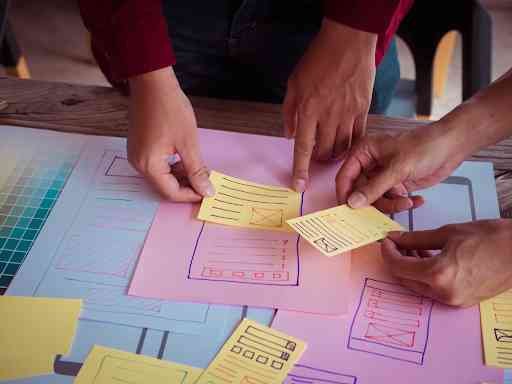In today’s rapidly evolving job market, where change is the only constant, individuals must adopt innovative strategies to foster career growth and stay competitive. One such strategy gaining prominence is “Design Thinking.” This creative problem-solving approach initially used in product and service design, has proven to be a powerful tool for shaping and advancing one’s career. In this article, we will explore the concept of “Design Thinking for Career Growth” and delve into practical ways to harness its principles to build a fulfilling and prosperous professional journey.
Understanding the Essence of Design Thinking
What Is Design Thinking?
Design Thinking is a human-centered problem-solving methodology that puts empathy, creativity, and iterative testing at its core. Originally employed by designers, it has found applications in diverse fields, including business and career development.
The Key Stages of Design Thinking
Design Thinking typically comprises five key stages:
Empathize: To solve any problem effectively, one must first understand it. This stage involves empathizing with the target audience, in this case, yourself. What are your career aspirations, goals, strengths, and weaknesses? What are the challenges and opportunities in your chosen field or industry?
Define: Once you’ve gained a deep understanding of your career landscape, it’s time to define your problem or goal. This involves crystallizing your career objectives, whether it’s landing a specific job, getting a promotion, changing industries, or pursuing further education.
Ideate: The ideation phase is all about generating innovative solutions. You brainstorm various paths and strategies to achieve your defined career goal. Here, creativity knows no bounds, and wild ideas are encouraged.
Prototype: After generating a range of ideas, it’s time to create prototypes or plans. These are not final solutions but rather practical and actionable steps to test your concepts in the real world. It could be as simple as updating your resume or as ambitious as enrolling in a relevant course.
Test: The final stage involves testing your prototypes in a real-world career environment. You gather feedback, evaluate what’s working and what isn’t, and refine your approach based on these insights.
Applying Design Thinking to Career Growth
Empathize with Yourself
The first step in applying Design Thinking to your career growth is to empathize with yourself. This means taking the time to reflect on your strengths, weaknesses, values, and passions. It also involves understanding your current career situation, whether you’re just starting out, looking to switch careers, or seeking advancement in your current role.
Why it matters: Empathizing with yourself allows you to gain clarity about your career goals and aspirations. It helps you identify the areas where you need improvement and understand the challenges you might face. Consider attending a design thinking workshop to enhance your ability to be empathetic.
Define Your Career Objectives
With a deep understanding of yourself and your career situation, it’s time to define your career objectives. Be specific about what you want to achieve in your career, both short-term and long-term. Whether it’s aiming for a managerial position, transitioning to a different industry, or becoming an expert in your field, clear objectives will serve as your guiding light.
Why it matters: Defining your career objectives provides focus and direction. It helps you set measurable goals and make informed decisions about the steps needed to reach them.
Ideate Career Paths and Strategies
Ideation in the context of career growth involves brainstorming various career paths and strategies to achieve your defined objectives. This is where creativity plays a significant role. Consider alternative routes, explore new industries, or envision unique ways to leverage your skills.
Why it matters: Ideation encourages you to think outside the box and explore unconventional career opportunities. It can lead to innovative solutions that may not be apparent through traditional career planning.
Prototype Your Career Plans
Once you have generated a range of career ideas and strategies, it’s time to prototype your career plans. Think of these prototypes as actionable steps or experiments. For instance, if your goal is to transition to a new industry, a prototype could be taking an online course in that field or networking with professionals already established in that industry.
Why it matters: Prototyping allows you to test your career ideas in a low-risk environment. It helps you gain valuable insights and adapt your plans based on real-world feedback.
Test and Iterate
Testing and iterating are crucial aspects of Design Thinking for career growth. It involves putting your career plans into action and continuously gathering feedback. This feedback loop allows you to refine your strategies and adapt to changing circumstances.
Why it matters: Testing and iterating prevent you from getting stuck in a rigid career plan that may no longer be relevant. It keeps your career journey dynamic and adaptable.
Essential 21st Century Skills for Professionals: DT to the Rescue
Design thinking is increasingly being recognized as an essential mindset for professionals in all fields. This is because it helps to develop the following 21st-century skills:
- Problem-solving: Design thinking teaches people how to identify and define problems in a way that is focused on the needs of the user. It also teaches people how to generate and evaluate solutions, and how to test and iterate on their ideas.
- Creative thinking: Design thinking encourages people to think outside the box and come up with new and innovative solutions to problems. It also teaches people how to prototype and test their ideas quickly and cheaply.
- Curiosity: Design thinking requires people to be curious about the needs of users and the challenges they face. It also teaches people how to learn from failure and iterate on their ideas.
- Collaboration: Design thinking is a team-based process that requires people to collaborate with others from different backgrounds and disciplines. It teaches people how to communicate effectively, listen to others, and build consensus.
Real-Life Applications of Design Thinking for Career Growth
Now that we’ve explored the fundamental principles of Design Thinking for career growth, let’s delve into some real-life applications and success stories.

Case Study 1 – Sarah’s Journey to Entrepreneurship
Background: Sarah had a stable corporate job for years, but she always harbored a dream of starting her own business in the fitness industry.
Empathize: Sarah began by understanding her passion for fitness and her desire for independence.
Define: She defined her career objective – to become a successful fitness entrepreneur.
Ideate: Sarah brainstormed various fitness-related business ideas, from opening a gym to launching an online fitness platform.
Prototype: She decided to start with a prototype – offering online fitness classes on a small scale to test the market.
Test: Sarah received feedback from her initial clients, made adjustments to her offerings, and gradually expanded her online fitness business. Today, she runs a thriving fitness platform with a loyal customer base.
Case Study 2 – David’s Transition to a New Industry
Background: David had been working in the automotive industry for over a decade but wanted a change. He was passionate about renewable energy and sustainability.
Empathize: David reflected on his passion for sustainability and his desire for a career aligned with his values.
Define: He defined his career objective – to transition into a role in the renewable energy sector.
Ideate: David explored various career options within the renewable energy field, from project management to research and development.
Prototype: He started by taking online courses in renewable energy and networking with professionals in the industry.
Test: David secured an entry-level position in a renewable energy company and continued to learn and grow in his new career.
Overcoming Challenges in Design Thinking for Career Growth

While Design Thinking can be a powerful tool for career growth, it’s not without its challenges. Here are some common obstacles and strategies to overcome them:
Fear of Failure
Challenge: Trying new career paths and strategies can be intimidating, as the fear of failure often holds individuals back.
Solution: Embrace failure as a learning opportunity. Remember that each setback brings you closer to success. Use Design Thinking to iterate and improve your career plans based on your experiences.
Lack of Resources
Challenge: Some career growth strategies may require resources such as time, money, or access to education and training.
Solution: Start with small, manageable steps that don’t require significant resources. Look for free or low-cost resources, scholarships, and online courses to acquire new skills and knowledge.
Resistance to Change
Challenge: Change can be challenging, especially if you’re considering a significant career shift.
Solution: Gradually introduce change into your career journey. Take small steps, and build confidence as you progress. Seek support and guidance from mentors or career coaches who can provide valuable insights and encouragement.
Conclusion
Design Thinking for career growth offers a dynamic and innovative approach to shaping your professional journey. By empathizing with yourself, defining clear objectives, ideating creative career paths, prototyping your plans, and continuously testing and iterating, you can navigate the ever-changing job market with confidence and resilience.
Remember that Design Thinking is not a one-time process but a continuous cycle. As you grow and evolve in your career, revisit these principles to adapt to new challenges and opportunities. Embrace failure as a stepping stone to success, leverage available resources, and be open to change.
In a world where career paths are no longer linear, those who can think creatively and adapt quickly will thrive. Design Thinking equips you with the mindset and tools to design the career of your dreams. So, start your journey today, and watch your career growth flourish through the power of Design Thinking.
About the author
Arpita Roy is a dreamer and a strong believer in the design thinking process. She believes design thinking and creativity are important ingredients for success and activate one’s innovative potential and the confluence of both helps unravel human behavior and their perceptions to solve wicked problems.
Before joining Humane Design and Innovation Consulting LLP, she worked on multiple design projects. She has more than 17+ years of industry experience across various domains. She has helped startups in conceptualizing and designing brand identity.
We at Humane Design strongly believe in the human ethos and draw inspiration from humans and other elements of nature to design innovative solutions for organizations of all sizes. We will be glad to be your success partner. Email us your requirements at explore@humaned.in.Connect with Us!



